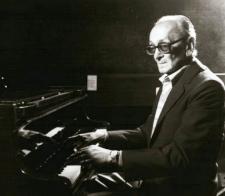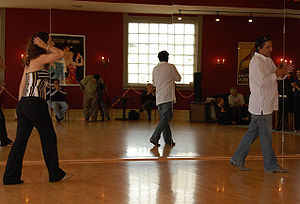
Astor Pantaleón Piazzolla was an Argentine tango composer, bandoneon player, and arranger. His works revolutionized the traditional tango into a new style termed nuevo tango, incorporating elements from jazz and classical music. A virtuoso bandoneonist, he regularly performed his own compositions with a variety of ensembles. In 1992, American music critic Stephen Holden described Piazzolla as "the world's foremost composer of Tango music".

Tango is a partner dance and social dance that originated in the 1880s along the Río de la Plata, the natural border between Argentina and Uruguay. The tango was born in the impoverished port areas of these countries from a combination of Rioplatense Candombe celebrations, Spanish-Cuban Habanera, and Argentine Milonga. It was frequently practiced in the brothels and bars of ports, where business owners employed bands to entertain their patrons. It then spread to the rest of the world. Many variations of this dance currently exist around the world.

Candombe is a style of music and dance that originated in Uruguay among the descendants of liberated African slaves. In 2009, the United Nations Educational, Scientific and Cultural Organization (UNESCO) inscribed candombe in its Representative List of the Intangible Cultural Heritage of Humanity.
Nuevo tango is both a form of music in which new elements are incorporated into traditional tango music, and an evolution of tango dance that began to develop in the 1980s.

Osvaldo Pedro Pugliese was an Argentine tango musician. He developed dramatic arrangements that retained strong elements of the walking beat of salon tango but also heralded the development of concert-style tango music. Some of his music, mostly since the 1950s, is used for theatrical dance performances. In Buenos Aires, Pugliese is often played later in the evening when the dancers want to dance more slowly, impressionistically and intimately.

Argentine tango is a musical genre and accompanying social dance originating at the end of the 19th century in the suburbs of Buenos Aires. It typically has a 2
4 or 4
4 rhythmic time signature, and two or three parts repeating in patterns such as ABAB or ABCAC. Its lyrics are marked by nostalgia, sadness, and laments for lost love. The typical orchestra has several melodic instruments and is given a distinctive air by the bandoneon. It has continued to grow in popularity and spread internationally, adding modern elements without replacing the older ones. Among its leading figures are the singer and songwriter Carlos Gardel and composers/performers Francisco Canaro, Juan D'Arienzo, Carlos Di Sarli, Osvaldo Pugliese, and Ástor Piazzolla.
María de Buenos Aires is a tango opera with music by Ástor Piazzolla and libretto by Horacio Ferrer that premiered at the Sala Planeta in Buenos Aires on 8 May 1968.

Laura Ana "Tita" Merello was an Argentine film actress, tango dancer and singer of the Golden Age of Argentine Cinema (1940–1960). In her six decades in Argentine entertainment, at the time of her death, she had filmed over thirty movies, premiered twenty plays, had nine television appearances, completed three radio series and had had countless appearances in print media. She was one of the singers who emerged in the 1920s along with Azucena Maizani, Libertad Lamarque, Ada Falcón, and Rosita Quiroga, who created the female voices of tango. She was primarily remembered for the songs "Se dice de mí" and "La milonga y yo".

Gustavo Naveira is an Argentine tango dancer and teacher who contributed to the detailed analysis of the movements of dancing to Argentine tango.
Nicole Nau is a German dancer of Tango Argentino and Argentine folklore living in Argentina and Germany.

Luis Pereyra is a dancer and choreographer of Tango Argentino and Argentine folk dances.
Figures of Argentine tango are elements of Argentine tango.

German Cornejo & Gisela Galeassi are an Argentine tango dance duo. They have been dancing together since early 2011, currently dancing for German Cornejo's Dance Company (GCDC), performing as lead dancers for the company. , Gisela and German won the title of World Tango Champions in 2003 and 2005, respectively, at the Campeonato Mundial de Baile de Tango . Both German & Gisela have appeared in numerous TV shows, Films and have toured extensively throughout the world. They have been judges in regional tango championships in Chile, Spain, Italy, Colombia and Japan. The duo is mostly known to Anglo-speaking audiences for their appearance in the American reality television show ¡Q'Viva!: The Chosen. and recently in America's Got Talent. They were winning finalists in Jennifer Lopez & Marc Anthony's TV show Q Viva culminating in the Las Vegas stage show of the same name in May 2012, at the Mandalay Bay Arena. In June 2012 they were JLO's special guest artists at her first-ever concert in Buenos Aires.

Olinda Bozán was an Argentine film actress and comedian of the Golden Age of Argentine Cinema (1940–1960). Born into a circus family, she acted on the vaudeville circuit, and performed in silent and sound movies. She was trained by the Podestá brothers, one of whom she married, who have one of the most prestigious Argentine acting awards named for them. Bozán' appeared in 75 films and was considered one of the best comic actors of Argentine cinema in the 20th century.
El Sonido de mi Tierra is a company from Argentina, for Tango Argentino and Folklore Argentino, founded by Luis Pereyra in 1996. "El Sonido de mi Tierra" means "The sound of my land". The Great Dance of Argentina is the international name of the same company, but used outside of Argentina and Spanish speaking countries. Both names are of the same company and same production.

Eliane René Schianni Bidart, was an Argentine tango singer, actress and dancer.

Alberto Bernardino Paz was an Argentine tango historian, teacher, and dancer. Alberto taught the traditional, social tango of the Buenos Aires salons, together with its codes and culture, to North Americans and Europeans.

Silvio Grand is a noted dancer and choreographer of the Tango dance form.

Lorena Ermocida is an Argentine tango dancer, teacher and choreographer.
Roberto Herrera is an Argentinian dancer, choreographer and dance teacher, known for the Tango.













